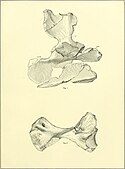Laozaur
| ||
| Laosaurus | ||
| Marsh, 1878 | ||
 | ||
| Systematyka | ||
| Domena | eukarionty | |
| Królestwo | zwierzęta | |
| Typ | strunowce | |
| Podtyp | kręgowce | |
| Gromada | zauropsydy | |
| Podgromada | diapsydy | |
| Nadrząd | dinozaury | |
| Rząd | dinozaury ptasiomiedniczne | |
| Podrząd | cerapody | |
| Infrarząd | ornitopody | |
| Rodzina | hipsylofodonty | |
| Rodzaj | laozaur | |
| Gatunki | ||
| ||
Laozaur (Laosaurus – "skamieniały jaszczur") – rodzaj dinozaura z rodziny hipsylofodontów. Gatunek typowy to Laosaurus celer opisany przez Marsha w 1878. Szczątki pochodzą z oksfordzko-tytońskiej (jura górna) formacji Morrison w Wyoming (Stany Zjednoczone). Z powodu ich fragmentaryczności rodzaj uznaje się za wątpliwy. Także drugi gatunek z tej samej formacji, L. gracilis, oraz trzeci z późnokredowej Alberty, L. minimus, nie są pewne.
Historia i taksonomia
Marsh nazwał rodzaj dzięki kręgom odnalezionym przez Samuela Wendella Willistona w Como Bluff w amerykańskim stanie Wyoming, w skałach wspomnianej już formacji Morrison. Były to dwa kompletne i dziewięć fragmentarycznych trzonów kręgów. Określono, że pochodzą od zwierzęcia wielkości lisa[1]. Jeszcze w tym samym roku nadał też nazwy dwóm nowym gatunkom: L. gracilis opisany został na podstawie trzonów kręgów grzbietu i ogona oraz części kości łokciowej[1][2], L. altus natomiast dzięki miednicy, kończynie tylnej i zębowi (YPM 1876)[3]. Peter Galton w 1983 wykazał, że typowy L. gracilis bazuje na trzynastu trzonach kręgów tułowia i ośmiu ogona, a także części tylnych kończyn[4]. Charles Whitney Gilmore przypisał mu jeszcze dodatkowe szczątki, w tym fragmentaryczny szkielet, bazując na rozmiarze[5][6], Galton przeniósł je jednak do innego taksonu, przypisując szkielet driozaurowi[4].
Przypisy
- ↑ a b Othniel Charles Marsh. Notice of new dinosaurian reptiles. „American Journal of Science and Arts”. 15, s. 241–244, 1878 (ang.).
- ↑ T.E. White. Catalogue of the genera of dinosaurs. „Annals of Carnegie Museum”, s. 117–155, 1973.
- ↑ Othniel Charles Marsh. Principal characters of American Jurassic dinosaurs. Part I. „American Journal of Science and Arts”, s. 411–416, 1878.
- ↑ a b Peter M. Galton. The cranial anatomy of Dryosaurus, a hypsilophodontid dinosaur from the Upper Jurassic of North America and East Africa, with a review of hypsilophodontids from the Upper Jurassic of North America. „Geologica et Palaeontologica”, s. 207–243, 1983.
- ↑ Charles W. Gilmore. A new rhynchocephalian reptile from the Jurassic of Wyoming, with notes on the fauna of "Quarry 9". „Proceedings of the U.S. National Museum”, s. 35–42, 1909.
- ↑ Charles W. Gilmore. Osteology of ornithopodous dinosaurs from the Dinosaur National Monument, Utah. „Memoir of the Carnegie Museum”, s. 385–409, 1925.
Media użyte na tej stronie
Autor:
- derivative work: Dinoguy2 (talk)
- Spinosaurus_BW.jpg: ArthurWeasley
Spinosaurus aegyptiacus, a spinosaurid from the Middle Cretaceous of Egypt
Autor: Drawing by John Conway [1], Licencja: CC-BY-SA-3.0
Various ornithopod dinosaurs. Far left: Camptosaurus, left: Iguanodon, centre background: Shantungosaurus, centre foreground: Dryosaurus, right: Corythosaurus, far right (large): Tenontosaurus.
Autor: Carnegie Institution of Washington, Licencja: No restrictions
Title: Carnegie Institution of Washington publication
Identifier: carnegieinstitut55carn (find matches)
Year: 1907 (1900s)
Authors: Carnegie Institution of Washington
Subjects:
Publisher: Washington, Carnegie Institution of Washington
Contributing Library: MBLWHOI Library
Digitizing Sponsor: MBLWHOI Library
View Book Page: Book Viewer
About This Book: Catalog Entry
View All Images: All Images From Book
Click here to view book online to see this illustration in context in a browseable online version of this book.
Text Appearing Before Image:
PELYCOSAURIA PLATE 31
Text Appearing After Image:
Ni laosaurus ci laviger.
Note About Images




